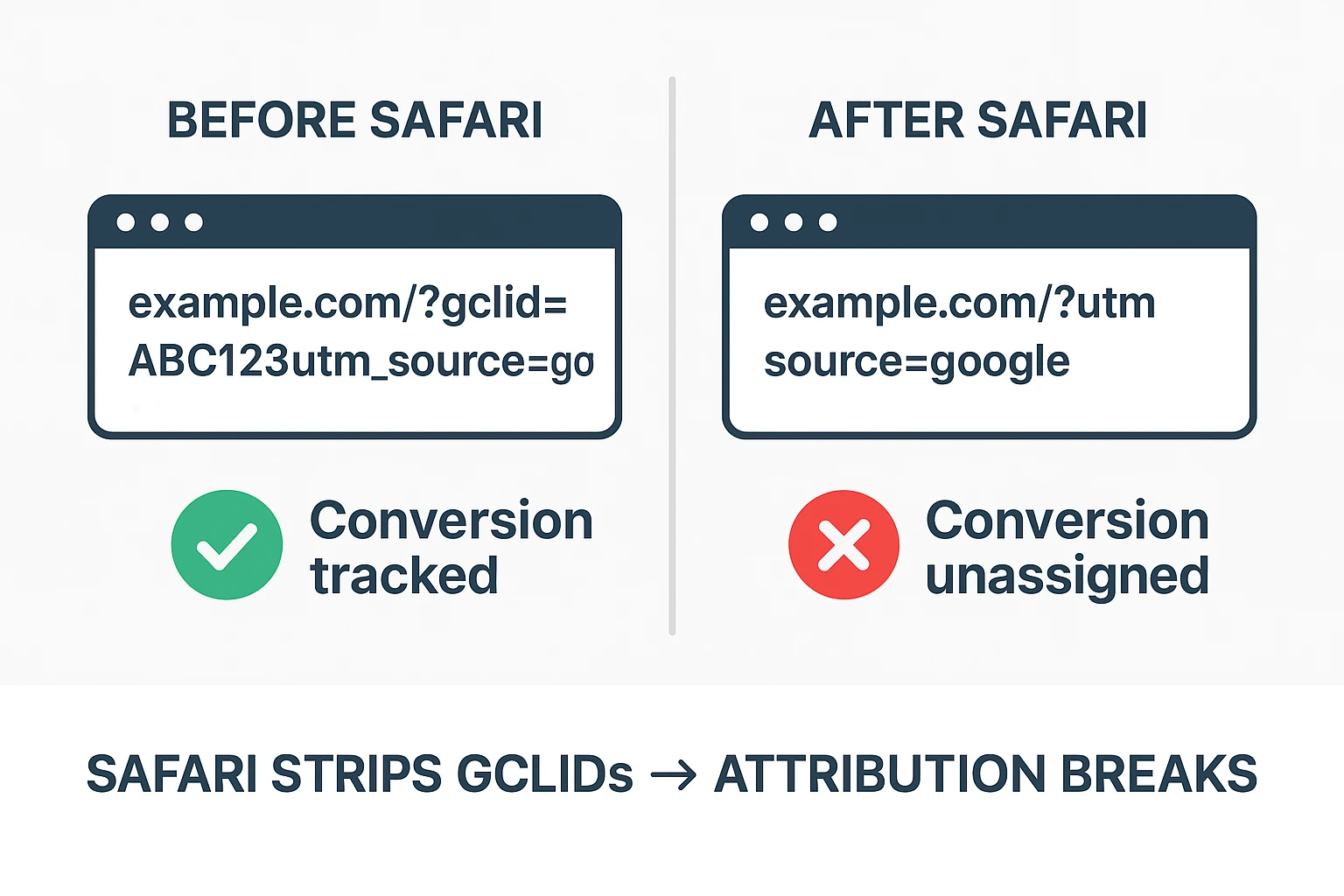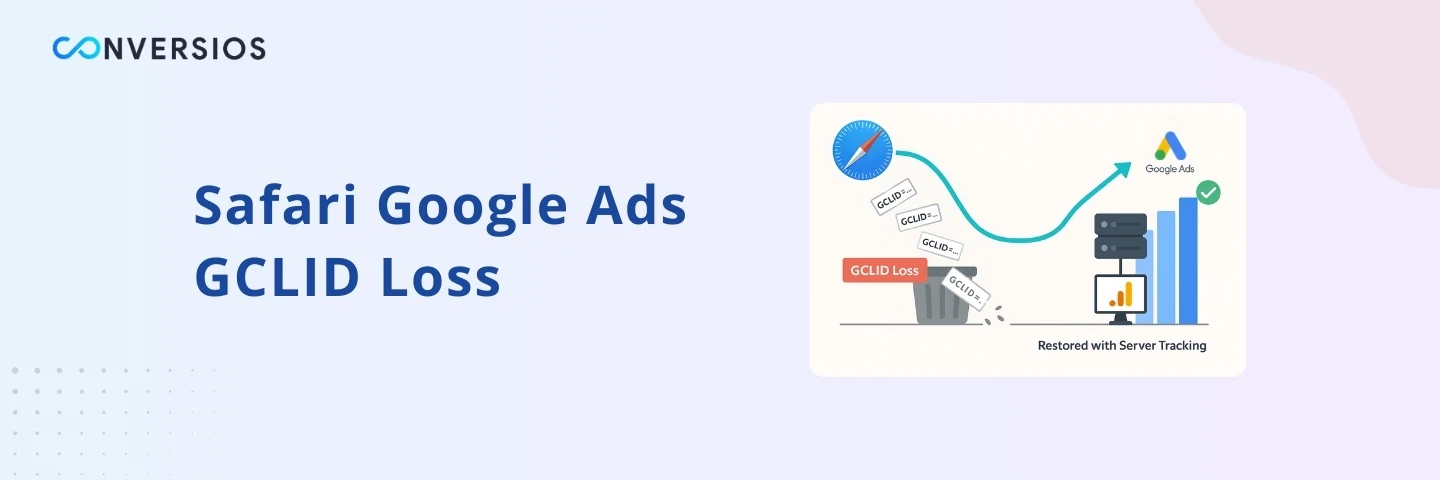If your Google Ads reports suddenly look weaker on Safari traffic, the culprit might not be your campaigns. It could be Apple. Safari’s privacy-first features are now stripping out the Google Click Identifier (GCLID), leaving advertisers with broken attribution and incomplete data.
The result? Conversions that actually came from ads get dumped into “Direct” or “Unassigned.” Smart Bidding gets fewer signals to optimize against. And remarketing audiences shrink overnight.
This article unpacks why Safari removes GCLID, how it affects your ad performance, and what you can do to protect your measurement before it gets worse.
What is GCLID in Google Ads and Why It Matters for Tracking
![]()
The GCLID, or Google Click Identifier, is a small parameter that Google Ads automatically attaches to your ad URLs. It looks like a random string of characters, but it’s actually the link between an ad click and the conversion that happens later.
Without GCLID:
- Google Ads cannot credit conversions back to the right click
- Smart Bidding doesn’t have reliable data to work with
- Your ROI reports no longer reflect the real picture
Think of GCLID as the glue that holds your click-to-conversion attribution together. When Safari removes it, the glue disappears.
Why Safari Strips GCLIDs and Breaks Google Ads Tracking

Apple’s Link Tracking Protection (LTP) is the reason. It’s part of Apple’s push to brand Safari as the most privacy-protective browser. LTP identifies and removes common click-level tracking parameters, including GCLID, before the page loads.
Currently, LTP applies in these scenarios:
- Safari Private Browsing
- Links opened through Apple Mail
- Links opened through Apple Messages
What gets stripped:
- GCLID (Google Ads)
- FBCLID (Facebook/Meta Ads)
- MSCLKID (Microsoft Ads)
What stays intact:
- UTM parameters like utm_source and utm_campaign
That’s why you’ll still see campaign data in GA4, but your click-level attribution in Google Ads looks broken.
Apple’s intent is clear: limit how advertisers follow users across sites. And if history is any guide, these protections could expand further into regular browsing in future Safari releases.
How GCLID Loss in Safari Impacts Google Ads Campaign Performance
Losing GCLID is not just an analytics inconvenience. It directly affects campaign performance and budget efficiency.
- Conversions misattributed: Sales from Safari users land in “Direct” instead of Google Ads, underreporting your ad ROI.
- Smart Bidding weakens: With fewer conversion signals, algorithms make less accurate decisions on bids.
- Audience shrinkage: Remarketing lists no longer capture Safari traffic, cutting your targeting pool.
- Budget risk: Under-reported performance may cause you to pull back on campaigns that are actually profitable.
If Safari is 20 percent of global browser share, imagine 1 out of 5 conversions silently falling out of your attribution. In some B2B and premium segments, the number is even higher.
How to Fix GCLID Loss in Safari with Reliable Tracking Solutions
There is no single toggle in Google Ads that solves this. The fixes require rethinking your tracking setup. Here are the main approaches:
Server-side tracking
Instead of relying on browser-level parameters, move collection to a server environment you control. Server-side Google Tag Manager can capture identifiers, manage cookies, and send clean data back to Google Ads even when Safari strips them.
👉 For a detailed step-by-step setup, check out our guide on fixing Safari GCLID removal 2025.
Enhanced Conversions
This feature uses hashed first-party data (like email or phone) to help Google match conversions back to clicks when IDs are missing. Even if the GCLID is gone, Enhanced Conversions increases attribution accuracy by 20 to 30 percent.
Stronger first-party data strategy
Privacy restrictions aren’t slowing down. Building a durable measurement strategy means collecting more consented first-party data. That includes email capture at checkout, customer IDs, and logged-in sessions that can be linked across devices.
Why You Need to Prepare for Safari GCLID Loss Now
It’s tempting to wait until you see major reporting gaps, but by then it’s too late. Once conversions start disappearing, you’ve already lost data that can’t be recovered.
- Safari is roughly 20 percent of the browser market
- Safari’s share is higher among premium consumers and B2B audiences
- Smart Bidding needs consistent conversion volume to work effectively.
Making changes early ensures you keep attribution stable and give Google Ads the signals it needs to optimize.
Key Takeaways on Google Ads GCLID Loss in Safari
- GCLID is essential for Google Ads attribution. Without it, your data becomes fragmented.
- Safari removes GCLID in Private Browsing, Mail, and Messages, while leaving UTMs intact.
- The impact is real: lost conversions, weaker bidding, smaller audiences, and skewed ROI.
- The durable fix is a combination of server-side tracking, Enhanced Conversions, and stronger first-party data.
- Start preparing now before Safari expands its protections further.
Frequently Asked Questions
Q. What is GCLID in Google Ads?
It is the Google Click Identifier, a parameter that links ad clicks to conversions.
Q. Why is GCLID missing in Safari?
Because Safari’s Link Tracking Protection strips it out in Private Browsing, Apple Mail, and Apple Messages.
Q. Do UTM parameters still work in Safari?
Yes. UTMs remain untouched, which is why you still see campaign-level reporting in GA4.
Q. How does GCLID loss affect Smart Bidding?
Smart Bidding relies on conversion signals. With missing GCLIDs, it receives fewer signals, which hurts optimization.
Q. Can Enhanced Conversions replace GCLID?
Not entirely, but Enhanced Conversions fill gaps by using hashed first-party data when click IDs are missing.
Q. Is this only a Safari issue?
At the moment yes, but other browsers are also tightening tracking rules. Preparing now protects you long term.
